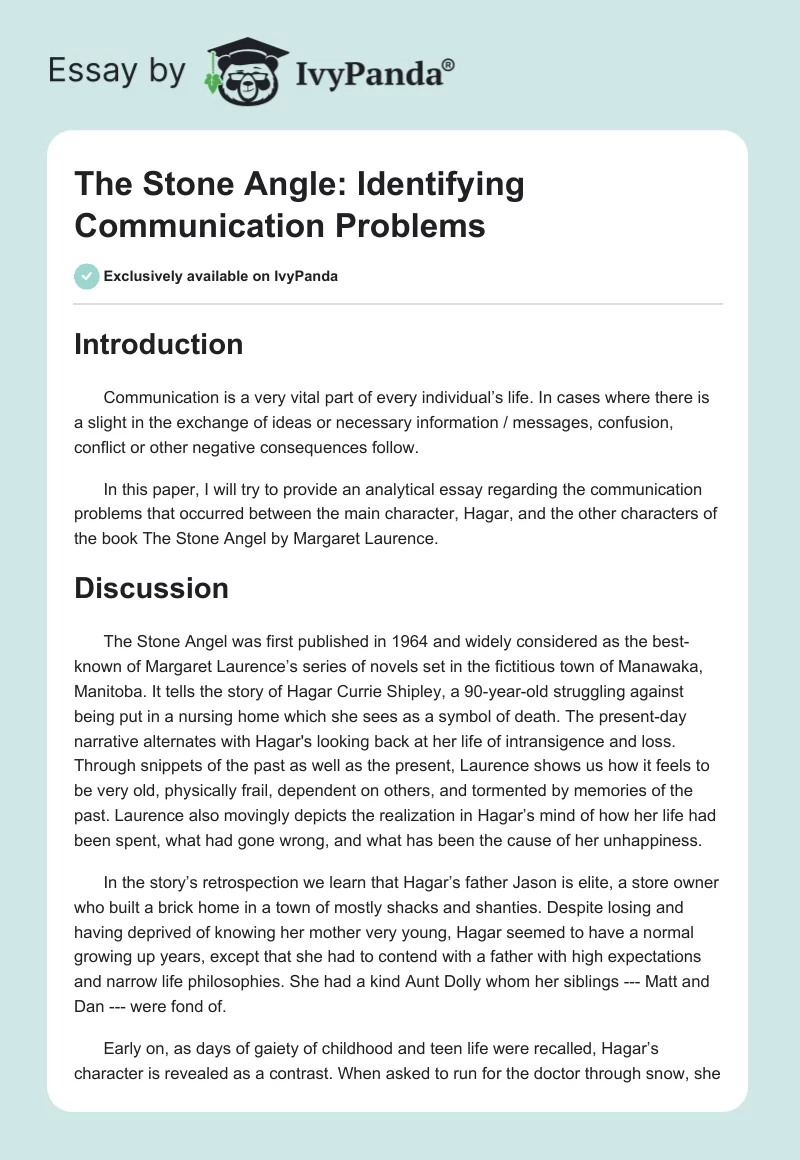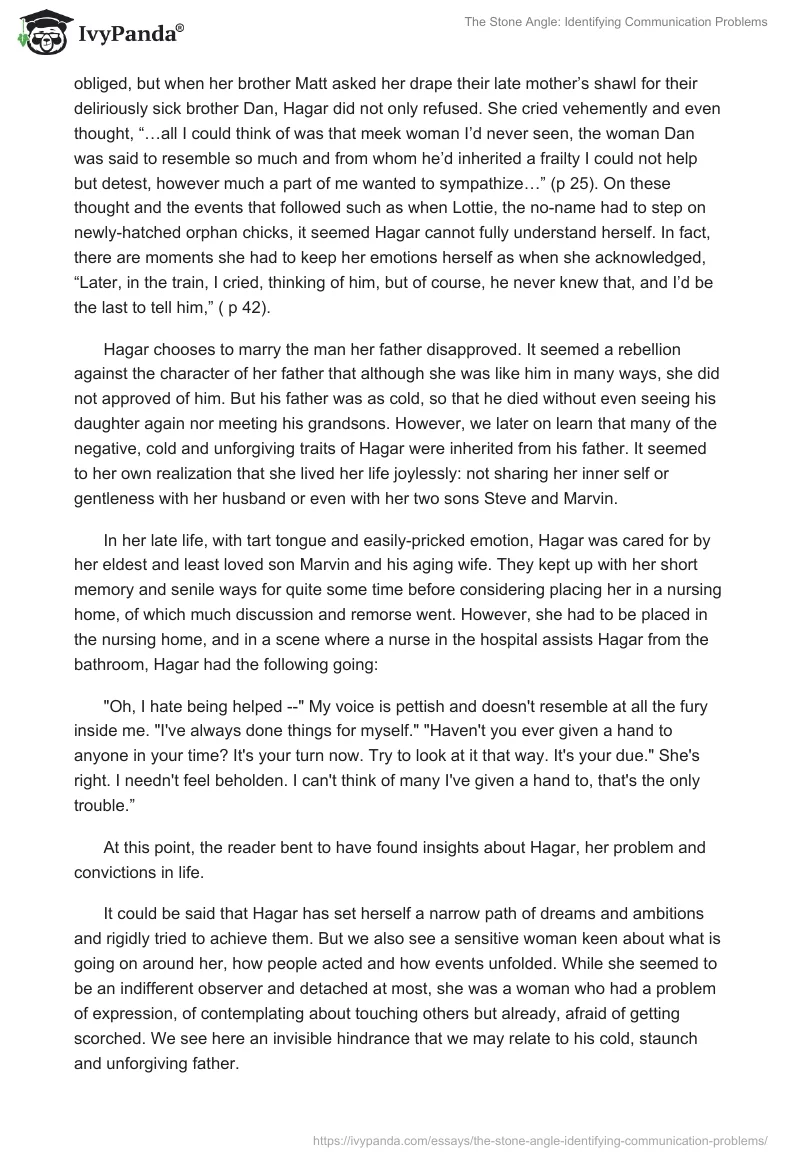Introduction
Communication is a very vital part of every individual’s life. In cases where there is a slight in the exchange of ideas or necessary information / messages, confusion, conflict or other negative consequences follow.
In this paper, I will try to provide an analytical essay regarding the communication problems that occurred between the main character, Hagar, and the other characters of the book The Stone Angel by Margaret Laurence.
Discussion
The Stone Angel was first published in 1964 and widely considered as the best-known of Margaret Laurence’s series of novels set in the fictitious town of Manawaka, Manitoba. It tells the story of Hagar Currie Shipley, a 90-year-old struggling against being put in a nursing home which she sees as a symbol of death. The present-day narrative alternates with Hagar’s looking back at her life of intransigence and loss. Through snippets of the past as well as the present, Laurence shows us how it feels to be very old, physically frail, dependent on others, and tormented by memories of the past. Laurence also movingly depicts the realization in Hagar’s mind of how her life had been spent, what had gone wrong, and what has been the cause of her unhappiness.
In the story’s retrospection we learn that Hagar’s father Jason is elite, a store owner who built a brick home in a town of mostly shacks and shanties. Despite losing and having deprived of knowing her mother very young, Hagar seemed to have a normal growing up years, except that she had to contend with a father with high expectations and narrow life philosophies. She had a kind Aunt Dolly whom her siblings — Matt and Dan — were fond of.
Early on, as days of gaiety of childhood and teen life were recalled, Hagar’s character is revealed as a contrast. When asked to run for the doctor through snow, she obliged, but when her brother Matt asked her drape their late mother’s shawl for their deliriously sick brother Dan, Hagar did not only refused. She cried vehemently and even thought, “…all I could think of was that meek woman I’d never seen, the woman Dan was said to resemble so much and from whom he’d inherited a frailty I could not help but detest, however much a part of me wanted to sympathize…” (p 25). On these thought and the events that followed such as when Lottie, the no-name had to step on newly-hatched orphan chicks, it seemed Hagar cannot fully understand herself. In fact, there are moments she had to keep her emotions herself as when she acknowledged, “Later, in the train, I cried, thinking of him, but of course, he never knew that, and I’d be the last to tell him,” ( p 42).
Hagar chooses to marry the man her father disapproved. It seemed a rebellion against the character of her father that although she was like him in many ways, she did not approved of him. But his father was as cold, so that he died without even seeing his daughter again nor meeting his grandsons. However, we later on learn that many of the negative, cold and unforgiving traits of Hagar were inherited from his father. It seemed to her own realization that she lived her life joylessly: not sharing her inner self or gentleness with her husband or even with her two sons Steve and Marvin.
In her late life, with tart tongue and easily-pricked emotion, Hagar was cared for by her eldest and least loved son Marvin and his aging wife. They kept up with her short memory and senile ways for quite some time before considering placing her in a nursing home, of which much discussion and remorse went. However, she had to be placed in the nursing home, and in a scene where a nurse in the hospital assists Hagar from the bathroom, Hagar had the following going:
“Oh, I hate being helped –” My voice is pettish and doesn’t resemble at all the fury inside me. “I’ve always done things for myself.” “Haven’t you ever given a hand to anyone in your time? It’s your turn now. Try to look at it that way. It’s your due.” She’s right. I needn’t feel beholden. I can’t think of many I’ve given a hand to, that’s the only trouble.”
At this point, the reader bent to have found insights about Hagar, her problem and convictions in life.
It could be said that Hagar has set herself a narrow path of dreams and ambitions and rigidly tried to achieve them. But we also see a sensitive woman keen about what is going on around her, how people acted and how events unfolded. While she seemed to be an indifferent observer and detached at most, she was a woman who had a problem of expression, of contemplating about touching others but already, afraid of getting scorched. We see here an invisible hindrance that we may relate to his cold, staunch and unforgiving father.
However, the reader needs to recall that Hagar never felt a mother’s warmth and love, of which she herself had developed a loathing beyond explanation. She never met her mother whom she already labeled as wimpy and weak. And of which she should not at all emulated, be likened, or compared with. We see here a denial, an after-effect of feeling of abandonment. Neglect.
No child would not want a mother. As Dokecki (1973) argued, the contact of a child to his or her mother represents the first socio-emotional interaction that in turn lays the foundations for its behaviors. It has also been suggested that social animals isolated from their mothers and lacking experience of nurturing physical affection develop severe depression.
Hagar developed communication problems. She remained like a stone, un-feeling, but observing. Beneath, the reader knows Hagar had an active mind and emotion, she felt as she showed to have her feelings hurt as when she is confronted with events that she does not like, as when Bram her husband had spoken to let her know of his plan to buy a horse, while she planned to have a furniture. This same expression of negation also came when she was told about Marvin and Doris’ plan to sell her big house and move to a smaller apartment instead, and finally, when she was asked to be placed to a nursing home.
In fact, her realization is quite obvious in this, “every joy I might have held in my man or any child of mine or even the plain light of morning…all were forced to a standstill by some break of proper appearances…When did I ever speak the heart’s truth,” (p. 292)
In the latter portion, as she approached death, the reader learns that she slowly subsides to a sober life, with a message to her least-liked son Marvin, “you’ve been good to me, always. A better son than John,” (p 304).
Conclusion
In all, what we read in The Stone Angel is a realistic depiction on the conflicts every individual may have experienced once or many times throughout the journey called life. In here, we see an elderly Hagar who had to live her life in full as she deemed fit, only to learn later on she lacked and lot a lot: mostly in conveying her affections and love to the people that was very much a part of her.
The reader will understand that the book’s title The Stone Angel referred to Hagar herself, who seemed to have become a stone watching events and people move, act, pass by. But she was an angel to have felt, and yet, did not express, who was hurt but who hide it well, who did not want to do something due to inexplicable hindrance that held her, and yet, later on, she would vividly realize all her mistakes, and the one person that mattered to her, her son Marvin finally received and established how she really felt. It could be very late, but it happened.
Reference:
Dokecki, P.R. (1973). “When the bough breaks…what will happen to baby. Review of: Rock-a-bye Baby.” Time Life Films (Lothar Woff, Ex. Prod.) Contemporary Psychology. 18:64.
Laurence, Margaret (1964). The Stone Angel. University of Chicago Press.


